
GreenLight Metals Intersects Significant Copper-Rich VMS Mineralization at Bend Project in Wisconsin Including 12.85m of 4.15% Copper Equivalent

Assays on Holes 1-3 Confirm High-Grade Copper with Significant Gold and Tellurium; Visual Observations Suggest Continued Success in Remaining Holes
GreenLight Metals Inc. (TSX-V: GRL) is pleased to announce the completion of its Phase 1 drilling program at the Bend copper-gold VMS Project in Wisconsin and report initial assay results from the first three holes. The six-hole diamond drilling program, totaling 2,037 meters, was completed from three sites along two sections entirely on the Company’s leased forty-acre tract of private minerals. Visual logging has been completed for all six holes, with assay results now received for holes B25-001 through B25-003. Results for holes B25-004 through B25-006, which encountered significant visual sulfide mineralization, are expected in the coming weeks.
Highlights
- Phase 1 Program Complete: Six-hole drilling program successfully completed on schedule, targeting eastern extensions of the known Bend deposit. Drilling confirms mineralization extends eastward along a ~36-42° plunge and remains open at depth and along trend.
- Initial Assays Confirm High-Grade Mineralization: First three holes return significant copper-gold intercepts including:
- B25-003: 12.85m (11.3m true thickness) @ 1.81% Cu, 1.75g/t Au, 22.7g/t Ag, 346.9g/t Te from 257.00m
- Including 3.56m (3.13m true thickness) of @ 2.68% Cu, 2.77g/t Au, 21.17g/t Ag, 481.54g/t Te from 257.00m
- B25-003: 12.85m (11.3m true thickness) @ 1.81% Cu, 1.75g/t Au, 22.7g/t Ag, 346.9g/t Te from 257.00m
- Significant Visual Sulfide Intercepts (assays pending):
- B25-004: 22.24m (17.8m true thickness) of massive to semi-massive sulfide from 276.29m (visual observation; assays pending), one of the thickest sulfide intervals logged to date at Bend
- B25-005: 8.79m (7.21m true thickness) of semi-massive to massive sulfide from 285.83m
- B25-006: 17.11m (11.98m true thickness) of semi-massive to massive sulfide from 328.52m
- Tellurium Included in Analytical Suite: The current analytical program includes tellurium; results for 6 samples within the B25-003 intercept exceeding the 500g/t detection limit are currently pending. As a designated critical mineral essential for renewable energy and defense applications, tellurium could add significant value to the project.
- Strategic Advantage: Program executed entirely on private mineral lands with existing permits, demonstrating GreenLight’s ability to advance exploration efficiently while federal permit applications remain pending.
Matt Filgate, President & CEO, commented: “These results mark a new beginning for the Bend Project. Not only is this the first drill program on the project since 2012 and the first in this area since 1994, but, based on visual logging, the 22.24-meter interval in hole B25-004 represents one of the thickest massive to semi-massive sulfide intercepts recorded on the property. Together with the long sulfide intervals logged in holes B25-005 and B25-006 (assays pending), these results support our interpretation that mineralization strengthens down plunge and remains open to the east. These early outcomes underscore the growth potential of the Bend volcanogenic massive sulfide system and position GreenLight to advance the project aggressively and systematically as the copper market strengthens.”
Phase 1 Drilling Results and Geological Context
The Phase 1 program successfully tested the eastern margin of the known Bend deposit along two sections. All drilling was conducted on the Company’s leased Soo Line Railroad forty-acre mineral tract. As previously disclosed, Phase 1 contemplated up to eight holes; six holes were completed in this initial phase, with the program utilizing the allocated meterage to pursue thicker mineralization encountered at depth.
The first two holes of the program intersected the upper margins of the Bend massive to semi-massive sulfide horizon and demonstrated a thickening of the mineralized section with depth. The program plan was then adapted to focus on testing the down-plunge continuity of thicker chalcopyrite-rich sulfide mineralization.
Stratigraphy across the drill area is consistent, with a sequence of rhyolite to dacite flows overlying interlayered fine ash to lapilli tuffs. Immediately overlying the semi-massive to massive sulfide horizon are laminated exhalative cherty tuffs and argillites (“hanging wall sediments”). The mineralized massive to semi-massive sulfide horizon is underlain by a thick Chlorite-sericite altered quartz-crystal (“quartz-eye”) tuff with strong disseminated and bedding-parallel pyrite (locally up to ~20%). The mineralized section of the deposit is underlain by a fine-grained chlorite-sericite tuff that marks the footwall contact of the deposit.
The recently completed drilling indicates a thickening of both the massive to semi-massive sulfide horizon and underlying mineralized crystal tuff unit with depth.
Table 1: Summary of Significant Intercepts – Holes B25-001 to B25-003
| DDH | From (m) |
To (m) |
Interval (m) |
True Thickness (m) |
Cu (%) |
Au (g/t) |
Ag (g/t) |
Te (g/t) |
Cu Eq (%) |
| B25-001 | 218.85 | 219.41 | 0.56 | 0.50 | 0.49 | 0.54 | 18.85 | 163.50 | 1.37 |
| B25-002 | 229.95 | 240.8 | 10.85 | 9.60 | 0.32 | 0.54 | 3.95 | 59.21 | 1.00 |
| Including | 229.95 | 231.27 | 1.32 | 1.17 | 1.20 | 0.39 | 5.84 | 102.94 | 1.73 |
| and | 239.9 | 240.8 | 0.90 | 0.8 | 1.52 | 1.60 | 21.90 | 323.00 | 3.67 |
| B25-003 | 257 | 269.85 | 12.85 | 11.3 | 1.81 | 1.75 | 22.70 | 346.90 | 4.15 |
| Including | 257 | 260.56 | 3.56 | 3.13 | 2.68 | 2.77 | 21.17 | 481.54 | 6.19 |
| and | 266.12 | 269.85 | 3.73 | 3.28 | 2.08 | 1.62 | 33.68 | 373.83 | 4.40 |
Copper Equivalents (Cu EQ) are calculated as an ‘in-situ’ value of the interval expressed in terms of combining the value of Cu, Au, and Ag at selected metal prices divided by the copper price and expressed as a percent copper. The calculations do not take into account factors such as metallurgical recoveries or payable metals and are shown for demonstrative purposes only. Tellurium (Te) is reported separately and is not included in the CuEq calculation.
The composite grades of select intervals in the table above are calculated on a length-weighted basis. Te overlimit analyses for samples >500 g/t Te are currently pending for 6 samples representing 5.29 meters of the 12.85m intercept in B25-003. The grade for this intercept was calculated using 500 g/t Te for these samples.
Cu Eq (%) = ((Cu grade (%) * 2204.6 * $4.50) + (Au grade (g/t) / 31.1035 * $3,600) + (Ag grade (g/t) / 31.1035 * $40)) / (2204.6 * 0.01 * $4.50)
Table 2: Visual Sulfide Observations – Holes B25-004 to B25-006 (Assays Pending)
| DDH | From (m) |
To (m) |
Interval (m) |
True Thickness (m) |
Geologic Description |
Est. Sulfide Content |
| B25-004 | 276.29 | 298.53 | 22.24 | 17.80 | Massive to semi-massive pyrite-chalcopyrite | ~75% Pyrite |
| ~8% Chalcopyrite | ||||||
| 298.53 | 312.1 | 13.57 | 10.86 | Sulfide-rich quartz crystal tuff | ~15% Pyrite | |
| ~0.5% Chalcopyrite | ||||||
| B25-005 | 285.83 | 294.62 | 8.79 | 7.21 | Massive to semi-massive pyrite- chalcopyrite |
~65% Pyrite |
| ~6% Chalcopyrite | ||||||
| 294.62 | 311.22 | 16.60 | 13.62 | Sulfide-rich quartz crystal tuff | ~12% Pyrite | |
| ~0.5% Chalcopyrite | ||||||
| B25-006 | 328.52 | 345.63 | 17.11 | 11.98 | Massive to semi-massive pyrite- chalcopyrite |
~55% Pyrite |
| ~6% Chalcopyrite | ||||||
| 345.63 | 351.05 | 5.42 | 3.79 | Sulfide-rich quartz crystal tuff | ~15% Pyrite | |
| ~0.5% Chalcopyrite |
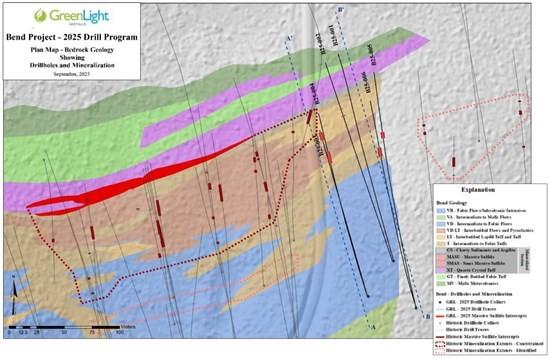
Figure 1: 2025 Drill Program Plan Map
Cautionary Note Regarding Visual Results and Photographs
Any references to “massive,” “semi-massive,” or “sulfide” intervals are based on visual estimates from core logging. Visual estimates and observations of sulfide minerals (e.g., pyrite, chalcopyrite) are not a proxy for grade and should not be used for resource estimation or economic evaluation. Sulfide mineralization percentages are estimates only. Photographs included in this release are of selected intervals and are not necessarily representative of mineralization throughout a hole. Assays are pending for select intervals and will be reported once received and validated.
Hole Details
- B25-001: Designed to test the eastern extension of previously intersected semi-massive to massive pyrite-chalcopyrite mineralization, the mineralized horizon was intersected at 218.85m with a 0.56m pyrite-chalcopyrite semi-massive sulfide zone. This intercept was interpreted as the ‘up-dip’ margins of the sulfide horizon at depth.
- B25-002: Designed to undercut B25-001 by 30m vertically from the same drill site, the mineralized horizon was intersected at 229.95m consisting of two stacked semi to massive sulfide lenses separated by well mineralized quartz-eye crystal tuff demonstrating a thickening of the mineralized section with depth. The upper lens was 1.32m thick while the lower lens was 0.90m and more massive in sulfide texture.
- B25-003: Set back 38m south and 30m west of the B25-001/002 section and designed to intercept the mineralized horizon 30m below historic hole B-7 (2.68m @ 1.95% Cu, 1.64g/t Au), B25-003 intersected 12.85m of semi-massive to massive pyrite-chalcopyrite sulfide from 257.00m to 269.85m. B25-003 also cored 3.6m of strongly pyrite mineralized quartz-eye crystal tuff immediately below the massive sulfide horizon. The results proved the working hypothesis that this drill campaign was vectoring towards a thickening of the massive sulfide lens down-plunge.
- B25-004: Collared on the same site as B25-003 and designed to test down-plunge continuity 42m below B25-003 vertically, the mineralized horizon was intersected at 276.29m yielding 22.24m of semi-massive to massive pyrite-chalcopyrite sulfide hosting 75% pyrite and average 8% chalcopyrite throughout, locally up to 15%. B25-004 also intersected 13.57m of >15% pyrite in the footwall quartz-eye crystal tuff from 298.53m to 312.10m.
- B25-005: Collared as a 47m step back south on the same section as B25-001/002 to test down-plunge extent at 60m vertical depth below B25-002, the mineralized horizon was intersected at 285.83m with 8.79m of semi-massive to massive pyrite-chalcopyrite. This hole supported the hypothesis of a 36° to 42° plunge to the east. B25-005 also intersected 16.6m of strong pyrite mineralized footwall chloritized quartz-eye crystal tuff known for hosting gold mineralization from 294.62m to 311.22m.
- B25-006: Collared from the same site as B25-005 to test 60m down dip vertically, the mineralized horizon was intersected at 328.52m coring 17.11m of semi-massive to massive sulfides hosting 55% pyrite and 6% chalcopyrite overall. Similar to overlying holes, a 5.42m thick pyritic-rich footwall zone within the quartz-eye crystal tuff (>15% pyrite) was intersected from 345.63m to 351.05m.
Next Steps
- Pending Assays: Results for visual sulfide intercepts in holes B25-004 through B25-006 expected within 3-4 weeks
- Phase 2: Planning is currently underway for an expanded, winter drill program to follow up on the recent drilling success at the Bend project. Permitting efforts on both the federal properties (Prospecting Permit) as well as within the privately owned Soo Line Mineral Parcel are in progress to initiate a 5,000 – 6,000 meter drill program to further expand the deposit.
Table 3: Drill Collar Information
| Hole ID | Easting (m) |
Northing (m) |
Elevation (masl) |
Azimuth | Dip | Total Depth (m) |
| B25-001 | 688514.058 | 5018602.251 | 412.855 | 344.0 | 48.0 | 279.81 |
| B25-002 | 688512.840 | 5018601.978 | 413.468 | 342.0 | 58.0 | 307.24 |
| B25-003 | 688490.294 | 5018569.989 | 412.868 | 344.0 | 55.5 | 276.61 |
| B25-004 | 688491.065 | 5018570.208 | 412.871 | 344.7 | 65.0 | 368.20 |
| B25-005 | 688533.987 | 5018560.256 | 415.502 | 345.0 | 59.0 | 376.43 |
| B25-006 | 688534.039 | 5018560.161 | 416.008 | 344.0 | 67.0 | 428.85 |
*Coordinates in NAD83 UTM Zone 15N
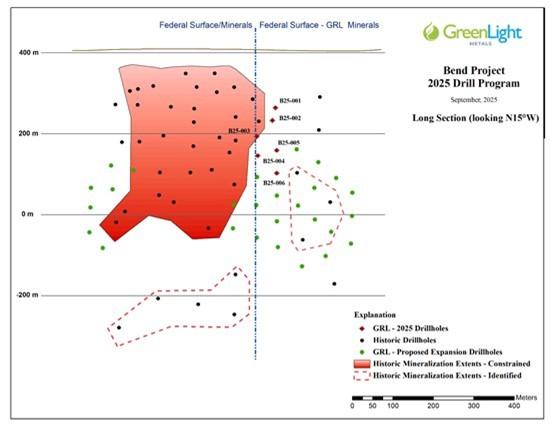
Figure 2: Long Section with DDH pierce points on plane of mineralization
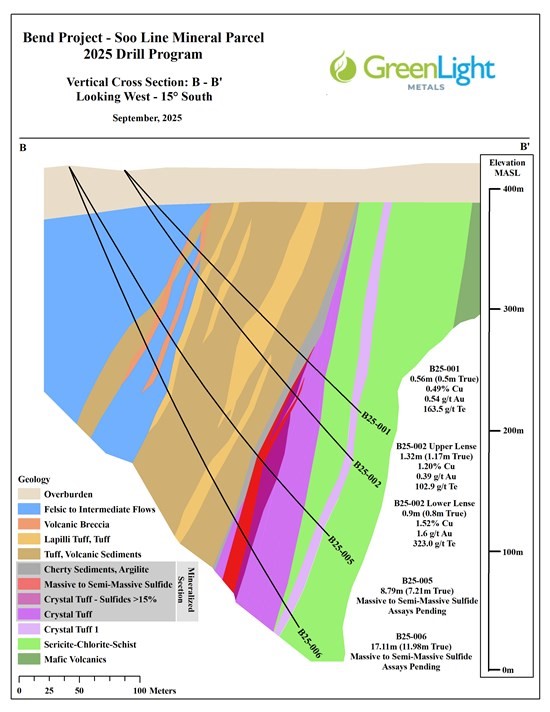
Figure 3: Cross Section B-B’
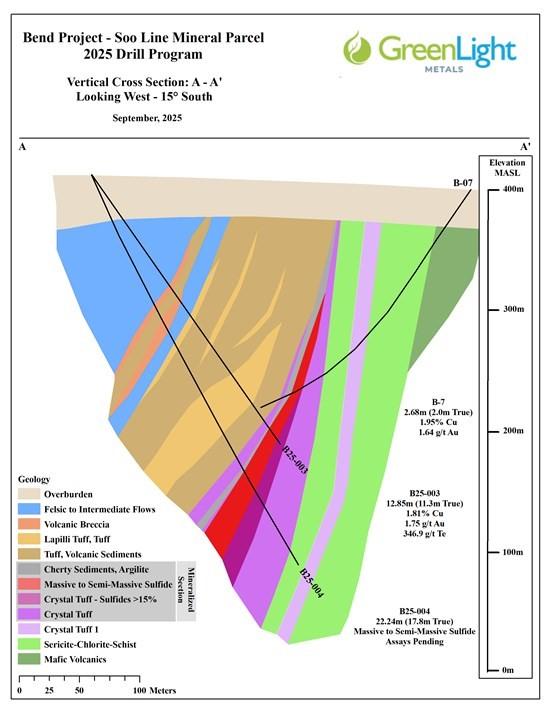
Figure 4: Cross Section A-A’
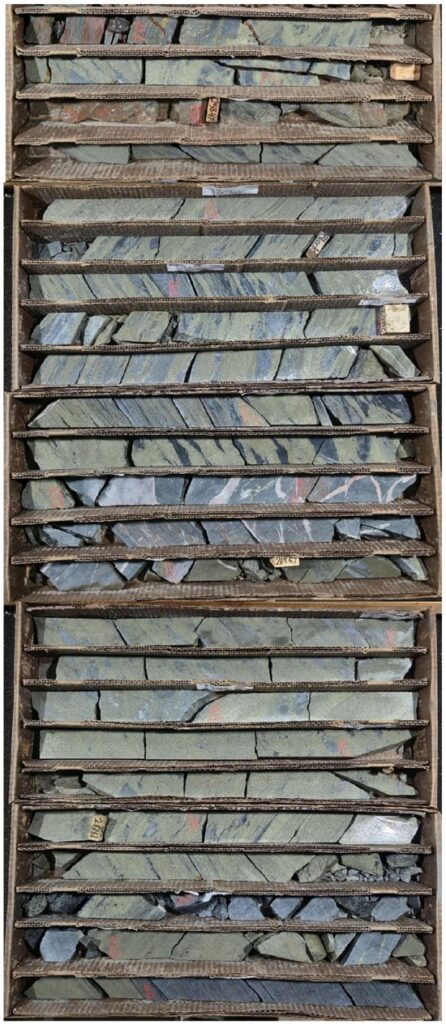
B25-003: 256.9m – 270.30m
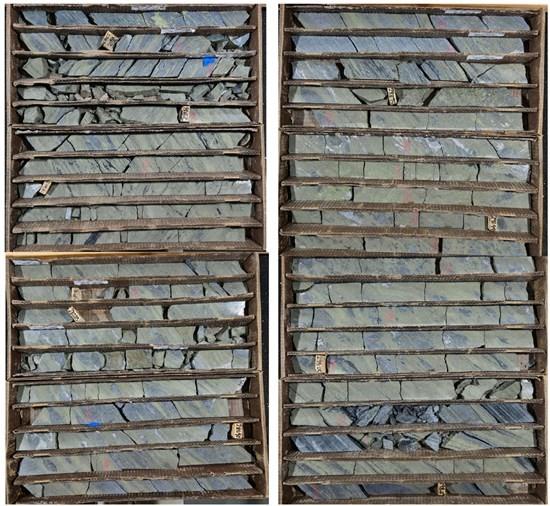
B25-004: 276.1m – 286.90m (Left) & B25-004: 286.90m – 298.20m (Right)
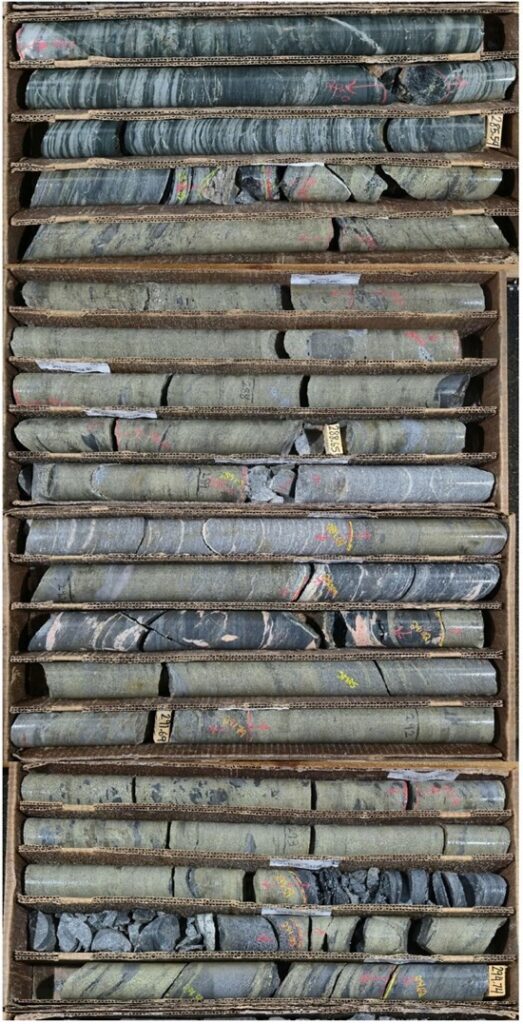
B25-005: 284.00m – 294.74m
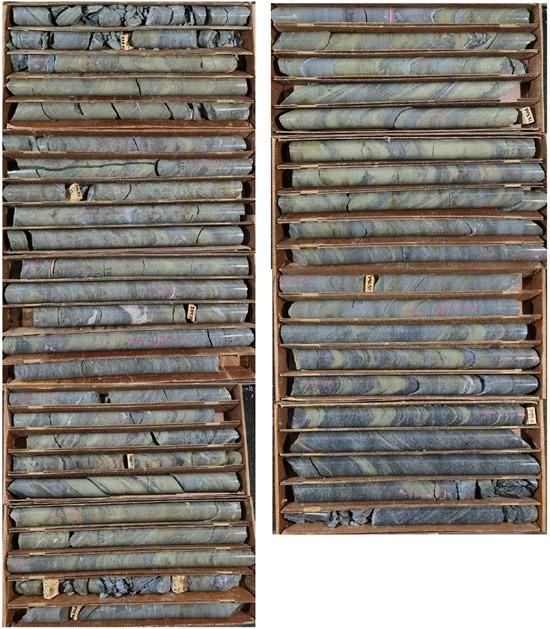
B25-006: 327.50m – 340.90m (left) & B25-006: 340.90m – 351.5m (right)
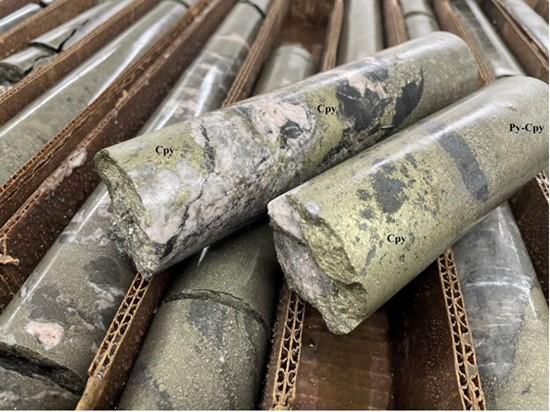
B25-004: 291.20m
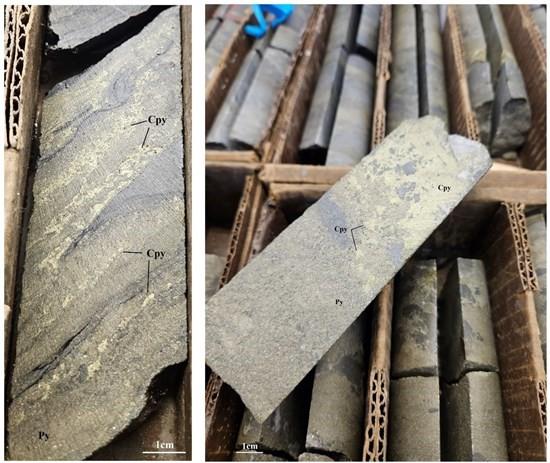
B25-005: 286.10m (left) & B25-004: 291.20m (right)
About the Bend Project
The Bend VMS Project represents an advanced exploration opportunity with a historical resource of 4.0 million tonnes at 1.74% Cu and 2.44g/t Au1. To date, over US$8 million has been invested in the project, including 59 diamond drill holes totaling 23,849 meters. Historical drilling highlights include 67.69 meters grading 1.01% Cu and 0.99g/t Au, including 27.6 meters at 2.40% Cu and 1.43g/t Au.
1This historical estimate does not comply with CIM Definition Standards on Mineral Resources and Mineral Reserves as required by NI 43-101 and has no comparable resource classification. A qualified person has not done sufficient work to classify the historical estimate as a current resource and GreenLight is not treating the historical estimate as a current resource. Significant data compilation, re-drilling, re-sampling and data verification will be required by a qualified person before the historical estimate on the property can be classified as a current resource. The Company is not treating the historical estimate as current mineral resources and the estimate should not be relied upon. Historical resource estimate reported in: Theodore A. DeMatties, PG, CPG, 2025, An Evaluation of the Bend VMS Project, NI 43-101 Technical Report.
Sample Preparation and QA/QC
Samples from the 2025 Bend drill program followed strict chain of custody from collection, through processing and delivery to ALS Global’s (“ALS”) laboratory in Twin Falls, Idaho. The drill core was delivered directly from the drill area to GreenLight’s core facility in Medford, WI. The drill core was inspected and sampled by GreenLight’s geologists who insert Certified Reference Materials (“CRMS”) and Blank material into the sampling stream and make up 10% of the total samples submitted to ALS. The drill core at the Bend project is drilled in NQ size (47.6mm) and is bifurcated by an electric masonry saw and placed in sentry sample bags sealed with zip-ties. Samples are shipped by ground directly to ALS via certified cartridge courier in rice bags secured on pallets. Samples are prepared using the ALS method PREP-31y which includes drying (if necessary) in an oven at a maximum temperature of 60°C, fine crushed of the sample to at least 70% passing less than 2mm and rotary split continuously through crushing via a Boyd RSD crusher-splitter. A 250g split sub-samples is then pulverized to 85% passing 75µm. Gold is analyzed by fire assay and inductively coupled plasma mass spectrometer (ICP-MS) if a 25g aliquot sample. (ALS Method Au-ICP21), while multi-element chemistry is analyzed by four acid digestion of a 0.25g pulverized sample split with detection by inductively coupled plasma mass spectrometer (ICP-MS) for 48 elements (Ag, Al, As, Ba, Be, Bi, Ca, Cd. Ce. Co, Cr, Cs, Cu, Fe, Ga, Ge, Hf, In, K, La, Li, Mg, Mn, Mo, Na, Nb, Ni, P, Pb, Rb, Re, S, Sb, Sc, Se, Sn, Sr, Ta, Te, Th, Ti, Tl, U, V, W,Y, Zn, Zr) (ALS method core ME-MS61). Gold assay method Au-ICP21 has an upper detection limit of 100ppm. Any sample that produced an over-limit gold value from ICP-MS is then sent for a gravimetric finish analysis. Samples that return copper assays greater than 1% Cu, the upper detection limit for ME-MS61 is sent for an “ore grade” analysis, in this case ALS method code Cu-OG46, which is a 0.4g aliquot pulverized sample with an ICP finish and an upper detection limit of 50% Cu.
Qualified Person Statement
The technical information in this news release has been prepared in accordance with Canadian regulatory requirements as set out in NI 43-101 and reviewed and approved by Thomas Quigley, MSc, CPG-11962, Exploration Director of the Company, a Qualified Person as defined by NI 43-101.
About GreenLight Metals Inc.
GreenLight Metals is a Wisconsin-focused exploration company advancing copper-gold and gold projects across the Penokean Volcanic Belt-one of North America’s most prospective VMS districts-and the Kalium Canyon epithermal gold project in Nevada’s Walker Lane. In Wisconsin, our portfolio includes the Bend copper-gold deposit, the Reef high-grade gold project, and the Lobo and Lobo East massive sulfide targets. Guided by a team with deep roots in the state, we are building a modern minerals company for Wisconsin, by Wisconsin-committed to responsible exploration, transparent engagement, and creating durable local opportunities as we help supply the critical metals that power the energy transition.
MORE or "UNCATEGORIZED"
Kuya Silver Confirms High-Grade Silver-Gold Vein Mineralization at Umm-Hadid with Initial Drill Results up to 1483.9 g/t AgEq over 2 Metres
Kuya Silver Corporation (CSE: KUYA) (OTCQB: KUYAF) (FSE: 6MR1) is... READ MORE
First Phosphate Closes Final Tranche of Oversubscribed Private Placement
First Phosphate Corp. (CSE: PHOS) (OTCQX: FRSPF) (FSE: KD0) is... READ MORE
GFG Receives Final Payment from the Sale of its Rattlesnake Hills Gold Project
GFG Resources Inc. (TSX-V: GFG) (OTCQB: GFGSF) announces that i... READ MORE
Goliath Receives $1,730,882 Through Warrant Exercises, Inclusive Of Crescat Capital A Longtime Strategic And Cornerstone Shareholder
Goliath Resources Limited (TSX-V: GOT) (OTCQB: GOTRF) (FSE: B4IF)... READ MORE
Robex Pours First Gold at Kiniéro on Schedule and Budget
Highlights: Gold bar weighing 2.64 kilograms (85 oz) poured in th... READ MORE












